At large concerts, music festivals or brand shows, LED displays are almost the soul of the stage. It is not only a background, but also an important tool for atmosphere creation, visual impact and audience interaction. So, how to use LED screens to be both cool and practical? Below are some of the design ideas for the LED screen on the concert stage to give you some reference.

1. Classic combination of home screen + secondary screen
The most common design is to place a large main screen in the middle of the stage, with sub-screens on both sides. The main screen is responsible for the overall visual display, such as close-ups of singers and background effects, while the secondary screen allows audiences from afar to see clearly. This layout is very traditional, but it is very practical and has relatively easy budget control. Generally speaking, a medium-configured stage LED screen price is between 80,000 and 150,000 US dollars, depending on the resolution and screen area.
2. Creative shape screen design
If you want to break the rules, you can try the special screen. For example, circular screens, diamond screens, wavy screens, and even make the screen into part of stage props. Many international music festivals will hang circular LED screens on the top of the stage, and rotate together with the lights, which is very shocking. The price of a special-shaped screen will be a little higher than that of a regular rectangular screen, because custom processing and control systems are more complex, and it is about $100-200 per square meter more expensive than a regular screen.
3. Transparent LED screen and space sense

Transparent LED screens have been particularly popular in the past two years, especially at the Electronic Music Festival. Its advantage is that it can not only play cool dynamic pictures, but also not completely block the lighting and structure behind the stage, creating a more layered stage design space. The audience will feel that the stage is deeper and more three-dimensional when they look at it. However, the brightness and resolution of transparent screens are generally not as good as conventional screens, so they are more suitable for ambient rendering. On the budget, the transparent screen is about US$1,200-1,800 per square meter.
4. Stage floor tiles screen interaction
In addition to the screen behind and above, LED screens can also be used on the ground. Many concerts will make the stage floor into LED floor tiles screens, and the singers will have interactive effects when walking, such as light wave diffusion effect when stepping on it. This design is very pleasing to the audience, especially in live shots, which makes the visual effect very extra points. However, floor tiles screens require load-bearing, anti-slip and waterproofing, and the cost is relatively high, about US$1,000-1,500 per square meter.
5. Wrap-up immersion screen
A more “money-burning” design is to make a wraparound LED screen, which surrounds the auditorium and creates an immersive experience. For example, in some large-scale tours, the stage not only has the main screen and the secondary screen, but also extends above and around the audience, giving people a feeling of entering the virtual space. This plan is suitable for top concerts, with a budget of at least $500,000.
summary
There is no fixed answer to the design of the LED screen on the concert stage, the key lies in the budget, venue size, performance style and audience experience. If it is just a small and medium-sized performance, it is enough to use the main screen + secondary screen; if it is a large music festival or brand press conference, you can consider transparent screens, special-shaped screens, floor tiled screens and even immersive designs. In general, LED screens are no longer just background tools, but part of stage expression.
Thank you for watching.


